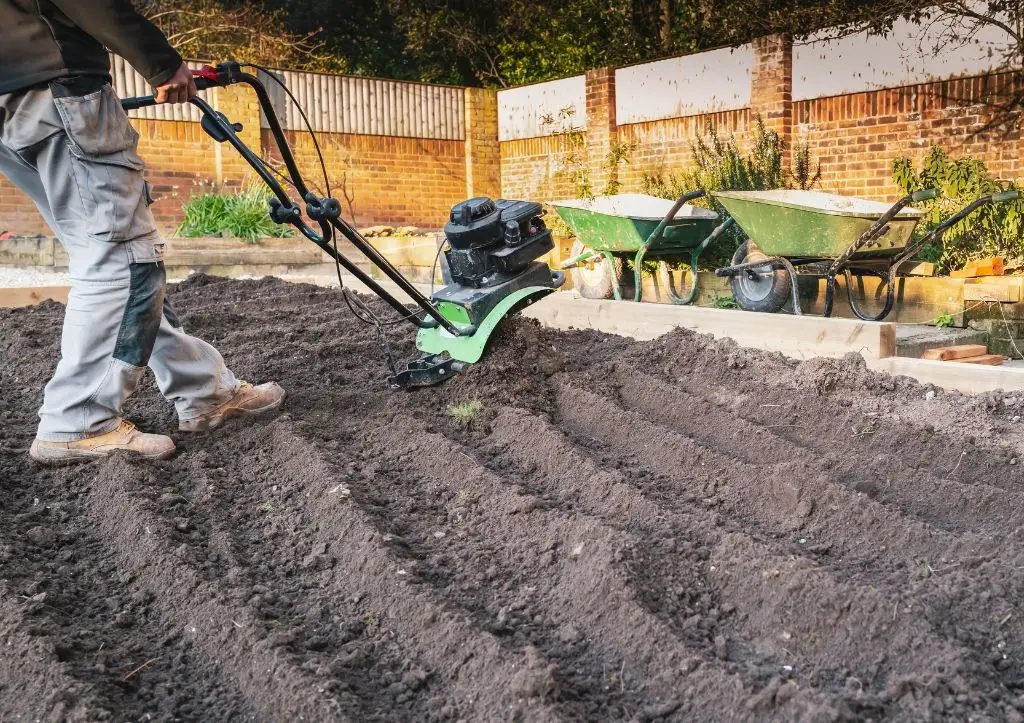At some point many gardeners will hear of rotavators and will wonder whether the investment in this piece of equipment is worthwhile.
Rotovators come in various sizes ranging from small to very large. This article focuses on using a rotavator and the questions that come from using or considering this piece of equipment.
Rotavators (also known as rotary tillers) are used to turn over soil, dig out weeds and loosen clods. They can also be used for crop drilling although a heavy duty drill is often preferred. You’ll find that rotavators have become essential items on some farms with the increased popularity of no-tillage but if you’re starting out on a smallholding it’s unlikely that this will be your main tillage implement.
What is a rotavator used for?
A rotavator is usually an electric or gasoline powered machine that has either a three-point hitch or is hand controlled and which can be used for a number of jobs.
It’s primarily used to dig up the soil, turn it over and then rake it level. But that’s not all it can do – here are some of the main uses:
You can use a rotavator to break up heavy soil in areas where the subsoil has broken through the top layer.
The rotavator will till these two layers together, giving you a good tilth making it easier for seeds to germinate and for young plants to grow.
Where to use a rotavator
Rotavators are a great tool to use on heavy soils such as thick clay or soils that have not been managed or farmed for many years.
Rotavators are also useful when you want to work wasteland or large areas of grassed soil, to turn into gardens or places to grow crops, which are renowned for being difficult and tough to manage and improve.
In these cases you can use the rotavator to tackle weeds, the machine will break the weeds and other growth up and will bury the remains into the soil so that they act as a form of organic compost.
Rotavators are commonly used on allotments when digging out rows for potatoes or other vegetables.
This is faster and easier than using a spade and will give you nice straight sides to your planting bed.
[amazon box=”B08X68C968″ template=”horizontal” title=”Electric Cordless Handheld Rotavator 7 inch working depth” description=” “]
Do I really need a rotavator?
It depends on the size of your plot, how often you intend to cultivate and what crops you’re growing.
Rotavators can do a great many jobs but it’s important to remember that they are not all purpose tools – a rotavator will take some of the pain away in terms of digging the dirt but that is all that it will do.
If you have a large area, such as an allotment, and you often need to dig, or if you are turning an unworked area into a garden or vegetable plot, for example, then a rotavator will save you a lot of time and energy.
Is there any difference between a tiller and a rotavator?
The main difference is in the rate that they can work – a tiller will always make more progress than a rotavator and it’s also worth keeping in mind that tillers are much lighter.
Tillers are often used to prepare seed beds for new plants by removing weeds and digging the ground over, preparing it for the seeds to be planted into.
Rotavators are good at breaking up clods, or heavier soils, and for turning over soil after you’ve already prepared it using a tiller.
You’ll find tiller attachments for rotavators but they’re not as effective as using a purpose-made tillers. If you have to do a lot of tillering a light duty tiller may be more effective and this will reduce the strain on your rotavator.
What is it like to use a rotavator?
Using an electric or gasoline powered machine can be noisy, quite awkward and hard work.
There are models which have levers rather than pedals but these are not really suitable for use on a smallholding or allotment.
You need to have reasonably strong arms as you’re digging through the soil, while at the same time pushing back clods and weeds.
A rotavator is especially tiring when it’s used in areas with dense growth, because of the extra effort involved in breaking down clods and roots.

Where should I use a rotavator?
Anywhere that needs digging – but because of the weight and size of this implement you won’t want to move it around too much.
It’s worth considering where you intend to set it up, particularly as regards your own safety and security.
Will a rotavator get rid of weeds?
No, but it will break them up and bury them in the soil.
To get rid of your weeds properly you will need to make sure that their roots have been removed and destroyed.
A rotavator will break the weeds into pieces but the chances are high that the weeds will return and re-grow.
[amazon box=”B07SH72BGY” template=”horizontal” title=”2 Stroke 50cc Gas Powered Rotavator – Lightweight and Easy to Operate” description=” “]
How much does a rotavator cost?
The price of these machines varies greatly, according to their size and the make/model.
Smaller electric models should be available for less than $300.
Petrol powered models can vary from around $600 right up to $3000.
How much does it cost to run a rotavator?
This depends on how often you use your machine and what type of fuel you have in it – petrol or electricity.
It’s worth considering that the amount of work that a rotavator can do is directly proportional to its size and power.
Smaller models will be easier to use and carry out less work.
How much space do I need for my rotavator?
Make sure that you have enough room to manoeuvre your machine, especially before it’s fitted with the digging bar – a minimum of about 3m should be allowed between the edge of the implement and any walls or fences.
Ideally you’ll want enough room to manoeuvre without it hitting any obstacles, especially if you are planning on using a rotavator on an allotment.
What maintenance will I need to carry out?
You’ll need to check the oil and the fuel filters regularly and keep all bolts and clamps tight.
The drive belt will need to be replaced periodically and you should check the machine for any loose fittings.

How safe is a rotavator?
Injuries to users aren’t unheard of but it’s worth remembering that the most common injuries have been at times when untrained people have used a rotavator, without knowing how to operate it properly.
There are a number of safety features built into the design of rotavators and it’s worth reading the instructions carefully before you attempt to use one.
Rotavators should not be used if the ground is frozen or wet, so always check before you start work.
Final Words
There are many different tools available for use in the garden, but none is more useful than a rotavator.
A rotavator will allow you to dig up sod, break clods of dirt, dig out roots, turn over soil and generally do all of the hard work that needs to be done during spring or fall seasons when other types of tools aren’t as effective because they can’t handle wet or frozen ground.
Available as either electric powered or gasoline driven, they come in a range of power outputs and are often available with a variety of add on features to help you to be extra productive with your gardening.
Read Next
7 Best pole saws for the garden






